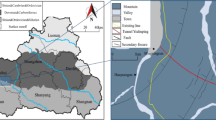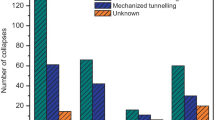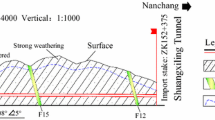Abstract
As a key risk source for tunnel engineering, the entrance section of tunnel is extremely easy to collapse. By analyzing the collapse of the entrance section of Taojiakuang Tunnel, the deformation characteristics before the tunnel collapsed were obtained. From the aspects of construction method and advanced support, three kinds of working conditions were considered to optimize the original design. From the perspective of safety and economy, the original advanced support design is unreasonable, and the conversion of the center cross diagram method to the center diagram method is not appropriate. For construction of tunnel entrances in weak broken rock, it is necessary to use the appropriate excavation method. When changing construction method, it is necessary to carry out sufficient demonstration and then re-construction to prevent the initial deformation of the surrounding rock from being too large and causing the tunnel to collapse. When encountering a weak broken zone, especially a rock formation boundary, it is necessary to increase the length of the advance support. The study provides a technical reference for similar projects.










Similar content being viewed by others
References
Gao F, Tan X (2010) Stability analysis on large section tunnel with double-side-drift method. J ChongQing JiaoTong Univ (Natl Sci) 29(3):363–366+440 (in Chinese)
Hilar M (2011) 3D modelling of a tunnel re-excavation in soft ground. Acta Polytech 51(3):25–31
Huang W, Li C, Zhang L et al (2018) In situ identification of water-permeable fractured zone in overlying composite strata. Int J Rock Mech Min Sci 105:85–97 (in Chinese)
Li Y (2018) Optimization of excavation sequence of large section tunnel entrance section with shallow-buried eccentric pressure. Highway 63(02):286–291 (in Chinese)
Li S, Xu F, Li L et al (2016) State of the art: challenge and methods on large deformation in tunnel engineering and introduction of a new type supporting system. Chin J Rock Mech Eng 35(7):1366–1376 (in Chinese)
Li Y, Zhang S, Zhang X (2018) Classification and fractal characteristics of coal rock fragments under uniaxial cyclic loading conditions. Arab J Geosci 11(9):201 (in Chinese)
Lu Y, Chen L, Feng W et al (2009) Bolt-shotcrete support and small pipe grouting technology used in treating tunnel collapse. J Chongqing Univ 32(05):572–576 (in Chinese)
Shi G, Yang X, Yu H et al (2019) Acoustic emission characteristics of creep fracture evolution in double-fracture fine sandstone under uniaxial compression. Eng Fract Mech 210:13–28 (in Chinese)
Song Z, Wang T, Zhou J et al (2017) Analysis of construction optimization and mechanical characteristic of shallow large section tunnel. Chin J Undergr Space Eng 46(S1):729–732 (in Chinese)
Wei L, Liu Q, Huang P (2017) Research progress on large deformation mechanism and control countermeasures of soft rock tunnel in high ground stress. Highway 62(7):297–306 (in Chinese)
Wu Z, Qi T, Tang J (2012) Optimization analysis of construction method for shallow-buried tunnel with large section. Ind Constr 42(8):102–107 (in Chinese)
Xiong F, Jiang Q, Ye Z et al (2018) Nonlinear flow behavior through rough-walled rock fractures: the effect of contact area. Comput Geotech 102:179–195 (in Chinese)
Xiong F, Jiang Q, Xu C et al (2019) Influences of connectivity and conductivity on nonlinear flow behaviours through three-dimension discrete fracture networks. Comput Geotech 107:128–141 (in Chinese)
Xu Z (2017) Application of combined support technology of pile foundation guide wall and long pipe roof in the tunnel-entering construction of weak surrounding rock. Constr Technol 46(S1):729–732 (in Chinese)
Yang Z, Gao Y, Wu S et al (2018) Optimization study of first liner replacement timing of large deformation tunnel based on convergence-constraint principle. Rock Soil Mech 39(S1):395–404 (in Chinese)
Zhang S, Li Y, Shen B et al (2019) Effective evaluation of pressure relief drilling for reducing rock bursts and its application in underground coal mines. Int J Rock Mech Min Sci 114:7–16 (in Chinese)
Zhou R (2015) Excavation method and settlement control measures of loess tunnel. Subgrade Eng 06:163–167 (in Chinese)
Acknowledgements
This study is supported by the Natural Science Foundation of Shandong Province (ZR2017MEE017), the Key R&D project of Shandong Province (Public Welfare Projects) (2018GSF120005), and the Natural Science Foundation of China (51174124).
Author information
Authors and Affiliations
Corresponding author
Ethics declarations
Conflict of interest
The authors declare that they have no conflict of interest.
Additional information
Publisher's Note
Springer Nature remains neutral with regard to jurisdictional claims in published maps and institutional affiliations.
Rights and permissions
About this article
Cite this article
Li, R., Han, N., Yuan, C. et al. Analysis and Design Optimization of Collapse Characteristics of Taojiakuang Tunnel Entrance Section. Geotech Geol Eng 38, 551–560 (2020). https://doi.org/10.1007/s10706-019-01045-2
Received:
Accepted:
Published:
Issue Date:
DOI: https://doi.org/10.1007/s10706-019-01045-2




